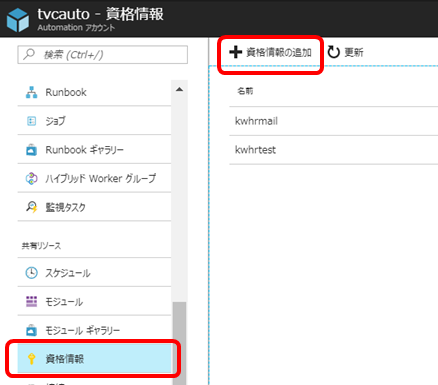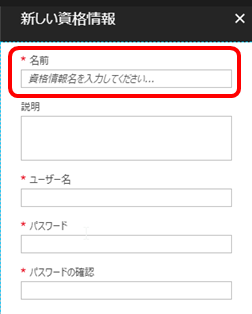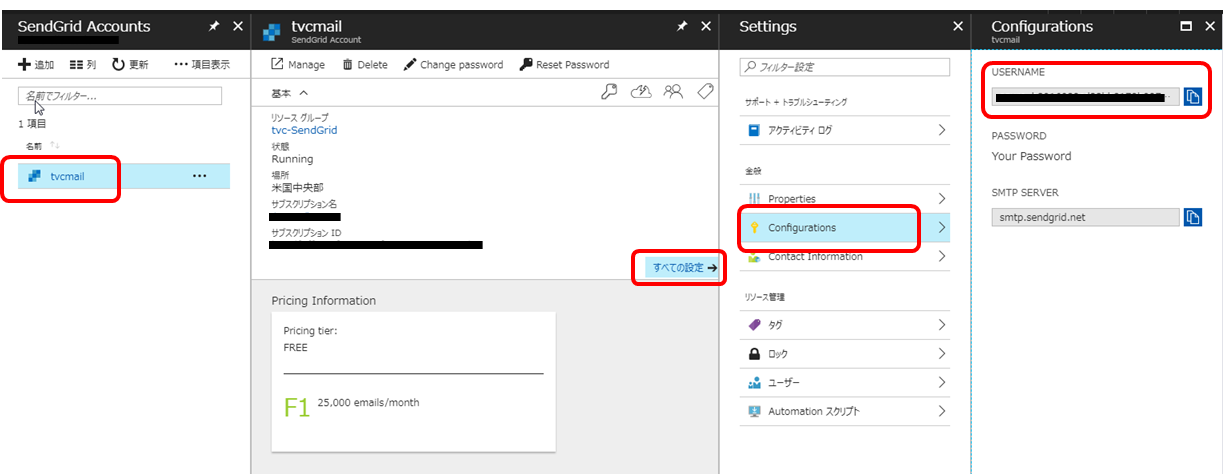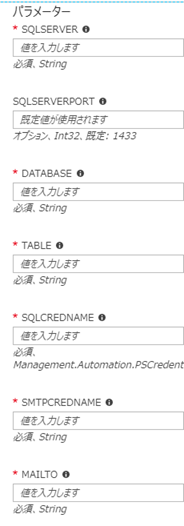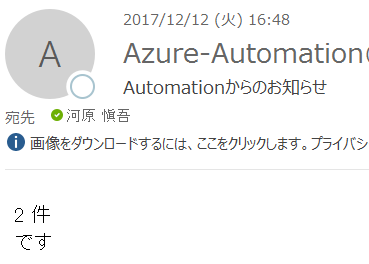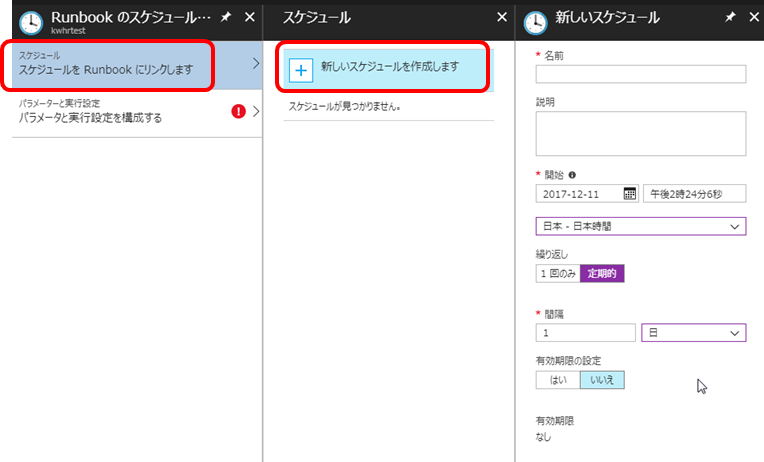SQL Databaseへの定期的なクエリ発行を、Azure Automationで実現しました。
指定したテーブルの件数を取得して、メール or Slack に通知する手順です。
メール通知はSendGridを使用しています。
SendGridアカウント作成
-
以下の記事が分かりやすかったので引用させて頂きました。
Azureのメール送信はSendGrid -
今回の手順ではAPIキーの発行は不要です。
Automationアカウント作成
-
以下の記事が分かりやすかったので引用させて頂きました。
Azure Automation で VM を自動停止する -
アカウントの作成と、Azureモジュールのアップデートまで実施しましょう。
Automation資格情報追加
Runbookの中でSendGridとSQL Databaseの認証にAutomation資格情報を利用します。
SendGrid資格情報を追加する
-
パスワードには、SendGridアカウント作成時に指定したパスワードを入力します。
SQL Database資格情報を追加する
- 上記手順と同様にSQL Databaseの資格情報を追加します。ユーザ名とパスワードには、SQL Databaseのユーザ情報を入力してください。
Email通知用Runbook作成
-
以下のコードを貼り付けます。workflow名はRunbookの名称と合わせるようにして下さい。
workflow kwhrtest
{
param(
[parameter(Mandatory=$True)]
[string] $SqlServer,
[parameter(Mandatory=$False)]
[int] $SqlServerPort = 1433,
[parameter(Mandatory=$True)]
[string] $Database,
[parameter(Mandatory=$True)]
[string] $Table,
[parameter(Mandatory=$True)]
[PSCredential] $SqlCredName,
[parameter(Mandatory=$True)]
[String] $SmtpCredName,
[parameter(Mandatory=$True)]
[string] $MailTo
)
# Get the username and password from the SQL Credential
$SqlUsername = $SqlCredName.UserName
$SqlPass = $SqlCredName.GetNetworkCredential().Password
# Get the username and password from the SMTP Credential
$SmtpCredential = Get-AutomationPSCredential -Name $SmtpCredName
inlinescript {
# Define the connection to the SQL Database
$Conn = New-Object System.Data.SqlClient.SqlConnection("Server=tcp:$using:SqlServer,$using:SqlServerPort;Database=$using:Database;User ID=$using:SqlUsername;Password=$using:SqlPass;Trusted_Connection=False;Encrypt=True;Connection Timeout=30;")
# Open the SQL connection
$Conn.Open()
# Define the SQL command to run. In this case we are getting the number of rows in the table
$Cmd=new-object system.Data.SqlClient.SqlCommand("SELECT COUNT(*) from dbo.$using:Table", $Conn)
$Cmd.CommandTimeout=120
# Execute the SQL command
$Ds=New-Object system.Data.DataSet
$Da=New-Object system.Data.SqlClient.SqlDataAdapter($Cmd)
[void]$Da.fill($Ds)
$html = $Ds.Tables[0].Rows[0][0]
# Close the SQL connection
$Conn.Close()
function EncodeSubject($s) {
$enc = [Text.Encoding]::GetEncoding("csISO2022JP")
$s64 = [Convert]::ToBase64String($enc.GetBytes($s), [Base64FormattingOptions]::None)
return [String]::Format("=?{0}?B?{1}?=", $enc.HeaderName, $s64)
}
$From = "[任意の送信元メールアドレス]"
$Subject = EncodeSubject(EncodeSubject("[メール件名]"))
Send-MailMessage `
-To $using:MailTo `
-Subject $Subject `
-Body "$html 件 <br /> です" `
-UseSsl `
-Port 587 `
-SmtpServer 'smtp.sendgrid.net' `
-From $From `
-BodyAsHtml `
-Encoding ([System.Text.Encoding]::UTF8) `
-Credential $using:SmtpCredential
}
}
-
パラメータ入力画面を以下の内容で入力します。
-
SQLSERVER : SQL Databaseサーバー名
-
SQLSERVERPORT : 1433
-
DATABASE : データベース名
-
TABLE : テーブル名
-
SQLCREDNAME : 前手順で任意の名前で作成した資格情報名を入力する
-
SMTPCREDNAME : 前手順で任意の名前で作成した資格情報名を入力する
-
MAILTO : メール送付先アドレス
Runbookスケジュール設定
-
[パラメータと実行設定]を選択し、以下のように入力する。
-
SQLSERVER : SQL Databaseサーバー名
-
SQLSERVERPORT : 1433
-
DATABASE : データベース名
-
TABLE : テーブル名
-
SQLCREDNAME : 前手順で任意の名前で作成した資格情報名を入力する
-
SMTPCREDNAME : 前手順で任意の名前で作成した資格情報名を入力する
-
指定した時間に実行されていれば成功
Slack通知用Runbook作成
-
E-Mail通知部分をSlack通知に置き換えてみます。
-
SlackのIncoming WebHooksを使っていますので事前にSlackでURLを取得しておいてください。
workflow kwhrtest-slack
{
param(
[parameter(Mandatory=$True)]
[string] $SqlServer,
[parameter(Mandatory=$False)]
[int] $SqlServerPort = 1433,
[parameter(Mandatory=$True)]
[string] $Database,
[parameter(Mandatory=$True)]
[string] $Table,
[parameter(Mandatory=$True)]
[PSCredential] $SqlCredName
)
# Get the username and password from the SQL Credential
$SqlUsername = $SqlCredName.UserName
$SqlPass = $SqlCredName.GetNetworkCredential().Password
inlinescript {
# Define the connection to the SQL Database
$Conn = New-Object System.Data.SqlClient.SqlConnection("Server=tcp:$using:SqlServer,$using:SqlServerPort;Database=$using:Database;User ID=$using:SqlUsername;Password=$using:SqlPass;Trusted_Connection=False;Encrypt=True;Connection Timeout=30;")
# Open the SQL connection
$Conn.Open()
# Define the SQL command to run. In this case we are getting the number of rows in the table
$Cmd=new-object system.Data.SqlClient.SqlCommand("SELECT COUNT(*) from dbo.$using:Table", $Conn)
$Cmd.CommandTimeout=120
# Execute the SQL command
$Ds=New-Object system.Data.DataSet
$Da=New-Object system.Data.SqlClient.SqlDataAdapter($Cmd)
[void]$Da.fill($Ds)
$html = $Ds.Tables[0].Rows[0][0]
# Close the SQL connection
$Conn.Close()
$msg = "$html 件です"
$enc = [System.Text.Encoding]::GetEncoding('ISO-8859-1')
$utf8Bytes = [System.Text.Encoding]::UTF8.GetBytes($msg)
$payload = @{
text = $enc.GetString($utf8Bytes);
username = "Azure Automation";
icon_emoji = ":azure:"
}
Invoke-RestMethod -Uri "[Slack WebHook URL]" -Method Post -Body (ConvertTo-Json $payload)
}
}
- Slackに通知されれば成功
補足
メールの件名に日本語が使えない?
通常はSend-MailMessageで-Encodingを付与すると、日本語で件名・本文を指定することが可能ですが、Automationで実行すると以下のエラーを吐きます。
Send-MailMessage : String contains invalid Unicode code points.
Parameter name: strInput
Automation側の問題のようで以下のように2重エンコードすると回避できました。
function EncodeSubject($s) {
$enc = [Text.Encoding]::GetEncoding("csISO2022JP")
$s64 = [Convert]::ToBase64String($enc.GetBytes($s), [Base64FormattingOptions]::None)
return [String]::Format("=?{0}?B?{1}?=", $enc.HeaderName, $s64)
}
$Subject = EncodeSubject(EncodeSubject("Automationからのお知らせ"))
以上
